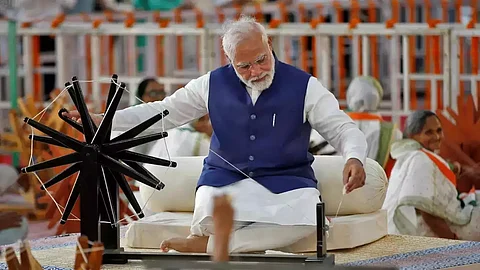

Khadi, the fabric that once symbolized India’s resistance against colonial rule, is experiencing a remarkable resurgence today, thanks to the convergence of Mahatma Gandhi’s vision and Prime Minister Narendra Modi’s execution of self-reliance policies. While Gandhi saw Khadi as more than just a piece of cloth—a movement for economic empowerment, unity, and independence—Modi's push for Khadi aligns with modern India’s aspirations of sustainability and economic revival. Together, these two leaders have paved the way for Khadi to not only embody national pride but also to serve as a catalyst for change in contemporary India.
Khadi's environmental benefits position it as a leading choice for a sustainable future. Unlike machine-made fabrics, Khadi is produced manually, without the consumption of electricity or large-scale industrial machinery, making its carbon footprint significantly lower. With only 3 liters of water required to produce a meter of Khadi fabric compared to the 55 liters used in mass-produced textiles, Khadi offers a more responsible alternative in an age when reducing water and energy consumption is critical. In a country like India, where water scarcity is becoming an increasingly pressing issue, choosing Khadi can help mitigate environmental strain.
Economically, Khadi has become a powerful tool for empowerment, especially in rural India. Over 10 lakh jobs have been created in the Khadi and Village Industries sector in the past decade, with a majority of these positions filled by women. This not only supports livelihoods but also promotes gender equality and rural development. The fabric, once seen as a symbol of sacrifice, is now also a source of income and opportunity.
Despite these advances, Khadi's journey towards mainstream adoption faces challenges. The younger generation, accustomed to modern, mass-produced clothing, often views Khadi as outdated. For Khadi to truly take root in today’s India, a concerted effort to rebrand it as a stylish and versatile fabric is needed. Collaborations with designers, as seen in events like Lakme Fashion Week, and increased visibility through social media campaigns can help bridge the gap.
By embracing Khadi, India can achieve a more self-reliant and sustainable future. It’s not just about wearing a piece of cloth—it’s about supporting rural economies, reducing environmental impact, and building a nation that is proud of its heritage and future.
